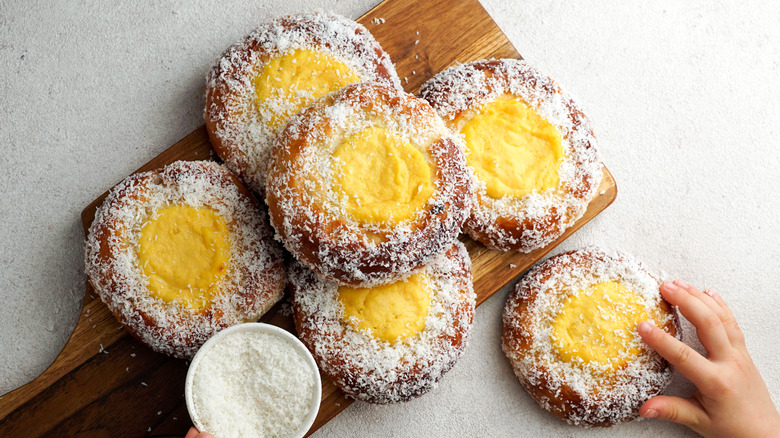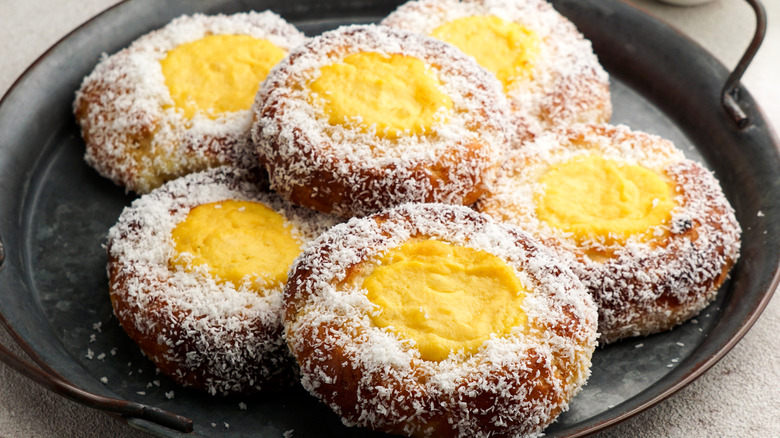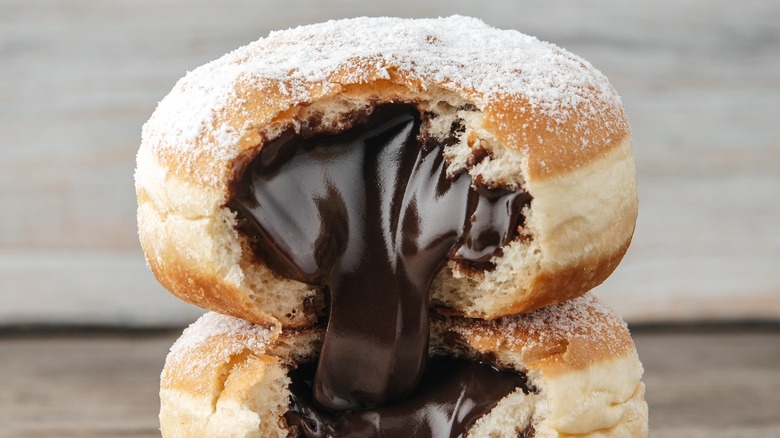Norway's Coconut Custard School Bread Is Ending The Donut's Career
Norway has given the world some truly out-of-this-world desserts. From Christmas-ready pepperkaker to buttery and airy eplekake, the Scandinavian country has been good to the food world for more than just brown cheese and underwater restaurants. Its coconut custard skolebrød — translated as school bread or school buns — is by far one of the country's most innovative and delicious designs.
The treat sort of resembles American donuts. Skolebrød is a sweet roll made from a milk-based, yeasted dough and baked (via food blog Living a Nordic Life). Their open custard centers, like sunny-side-up eggs, and desiccated coconut coats set them apart from the pack, making for excellent desserts that can be enjoyed at home or in your kid's lunchbox (hence the name).
The treats have been around at least since the 1950s. In Norway, they're a staple of bakeries and supermarkets, where freshly baked trays are often hastily purchased right out of the oven. Though they're found across the frigid country, they're only known as skolebrød in the north and east; in the west, they're called skolebolle; and in the Arctic parts of the country, Norwegians enjoy a variation called solskinnsboller, sunshine buns (via ScandiKitchen). In America, they're perhaps best known as school bread, found not in the coldest climates of the country, but rather on the menu of Kringla Bakeri Og Kafe in Epcot. Disney World notwithstanding, here's the dish on what makes skolebrød so good and whether it can compete with the diverse American donut.
How do you make skolebrød?
If you want to make your own skolebrød like you're sending your kids off to school into the Nordic winter, the recipe is actually as simple as many cookies, breads, and basic pastries. And it's going to be a lot more authentic than what you can find at any Epcot restaurant (sorry, Walt Disney Company).
Recipes from Living a Nordic Life and "Modern Scandinavian Baking" author Daytona Strong are easy to follow and yield delicious results, and each gets to the bottom of what makes skolebrød unique. For starters, skolebrød's dough is slightly unusual to the American palette. Like a standard donut recipe, they begin with warm milk mixed with yeast. From there, the dry ingredients combine with butter and egg. A little cardamom in the dough gives a sweet, floral, fruity note to the buns.
After some thorough kneading and time to rise, one creates indentations and fills them with a little pastry cream. From there, the final trick of skolebrød lies in the icing and coconut. They're brushed thoroughly with royal icing, then dipped in desiccated coconut.
Skolebrød vs. donuts
So is skolebrød like a Norwegian donut? Nope. The Nordic country already has one unique donut to its name: the smultring. This donut has been increasingly co-opted by American confectionary influences, but it's definitely a Norwegian specialty (via North Wild Kitchen). The skolebrød is, if anything, like the donut's cool, hot kid, a glorious treat all its own.
The cardamom in the dough means that even plain, the treats are more flavorful than the American donut. Since they're baked, they're healthier than their deep-fried counterparts, too. The custard adds a delight you might find in cream or fudge donuts, the coconut gives it an adult edge — is coconut any child's favorite flavor? — and the icing ties it all together in a sweet little package. Donuts are great for their variety, but the skolebrød brings a whole lot of variety in each individual sweet roll.
Internationally, skolebrød is similar to Japanese and Korean cream pans and the Czech koblihy. But the baked Norwegian treat combines complex flavors with airy enriched dough — plus, they're simple to prepare.


